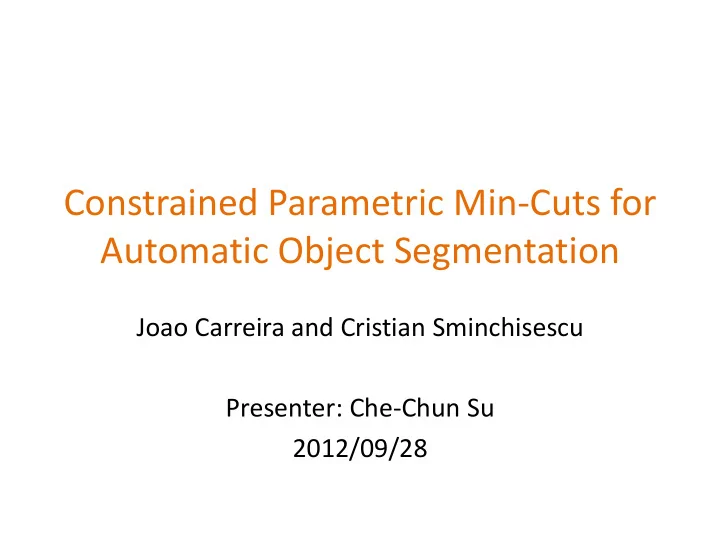

Constrained Parametric Min-Cuts for Automatic Object Segmentation Joao Carreira and Cristian Sminchisescu Presenter: Che-Chun Su 2012/09/28
Outline • Overview • Constrained Parametric Min-Cuts (CPMC) – Experiments • Example Images • Distorted Images • Ranking Object Hypotheses – Experiments • Depth/Disparity Cues • Discussion 2
Overview Figure credit: Joao Carreira et al. 3
Constrained Parametric Min-Cuts (CPMC) • Graph-based segmentation algorithm – Similarity between neighboring pixels is encoded as edges. 4
Constrained Parametric Min-Cuts (CPMC) • Multi-Cue Contour Detector – Estimate the posterior probability of a boundary. Figure credit: Michael Maire et al. 5
Experiments • Segmentation Covering 6
Experiments • Example Images 7
Experiments • Example Images 8
Experiments – Distorted Images • Will different distortions in images affect the segmentation performance? • Will the distortion degrade the quality of the estimated posterior probability of boundary? • LIVE Image Quality Database – Gaussian blur – JPEG compression – White noise 9
Test Images Reference Blur White Noise JPEG 10
Probability of Boundary Map Reference Blur White Noise JPEG 11
Experiments • Reference 12
Experiments • Blur 13
Experiments • JPEG 14
Experiments • White Noise 15
Ranking Object Hypotheses Figure credit: Joao Carreira et al. 16
Experiments • Can depth cues help rank the object hypotheses? – Depth are continuous; however, objects can be seen as residing in different depth planes. • Middlebury Stereo Datasets – Ground-truth disparity maps • LIVE Color+3D Database – Ground-truth range maps 17
Experiments • Append the feature with depth/disparity cues and retrain the ranking model with multiple linear regression. 18
Experiments • Middlebury Stereo Datasets – Indoor scenes with ground-truth disparity maps – Different types of objects – Ranking model is trained on LIVE Color+3D database. 19
Experiments 20
Original Features 21
New Features and Regressor 22
Original Features 23
New Features and Regressor 24
Original Features 0.196388 0.452087 0.505323 0.615173 25
New Features and Regressor 0.196388 0.424314 0.490003 0.450192 26
Experiments • LIVE Color+3D Database – Natural scenes with ground-truth range maps – Quantize actual range values to generate depth planes. – Ranking model is trained on Middlebury stereo datasets. 27
Experiments 28
Experiments 29
Original Features 30
New Features and Regressor 31
Original Features 0.407832 0.337091 0.133830 0.187111 32
New Features and Regressor 0.407832 0.333177 0.133830 0.179389 33
Discussion • Different types of distortions in images can affect the segmentation results. – Probability of boundary map is distorted. – CPMC generates incorrect figure-ground (object) hypotheses. • Ranking model can be governed by different types of segment features and properties. – Depth cues could possibly help recognize objects, and vice versa. 34
Recommend
More recommend